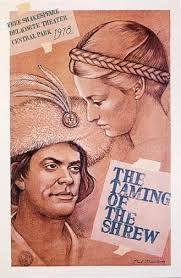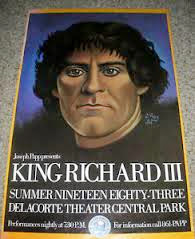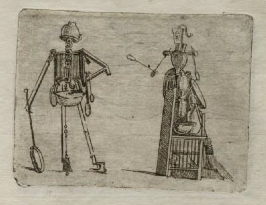 |
| Detail of a "Public" Poster (for Hamlet) painted by Paul Davis. |
 |
| Director Joe Papp |
 |
| Artist Paul Davis |
ART
PAUL DAVIS
PAINTS THE "FACES"
of the
PUBLIC THEATER,
NYC
Last week, the Public Theatre turned the lobby of its Newman Theatre into a gallery showing an exhibition of their theatrical-posters by artist Paul Davis. For sixteen years his collaboration with the theatre’s founder, Joe Papp, put the promotional face on the Public's productions.
Davis, originally from Oklahoma and now seventy-six years old, first started working with Papp in 1975, after achieving notoriety as an artist with Push Pin Studios, in New York. At that time theatrical-posters mostly used typography, not images to promote a production. Davis was determined to show what the actors and the director were trying to communicate to the audiences during the performances in his posters. Papp also thought "the Public" was a place where he could create a conversation about each important issue.

 |
| A book of Paul Davis' posters and paintings is available at Amazon.com. |
FOOD
Crêpe Suzette
Crêpe Suzette is a French dessert consisting of a crêpe with a sauce of caramelized sugar and butter, orange juice, orange zest, and liqueur on top. It is flambé (usually table-side) before being served.
Directions:
- first make basic crepes, stack & set them aside
Ingredients
- place 2 knobs of butter in a crepe pan- add 2 tablespoons sugar
- add 2 tablespoons orange zest (using zester)
- cut a large orange in half and add juice from 1/2
- Place each crepe in a pan and coat with sauce, then fold in-half
(2 crepes in each pan)
- fold crepe one more time (into a triangle)
- brown the crepe triangles on both sides
- add 1 oz. each of orange liqueur and cognac
- flambé the pan to burn off the alcohol
- shake the pan while you cook off the flame
- pour the crepes and sauce onto plates to serve
(some also add a scoop of good vanilla ice cream)
Basic Crepe Recipe
Ingredients
Original recipe makes 8 crepes
- 1 cup all-purpose flour
2 eggs
1/2 cup milk
- 1/2 cup water
1/4 teaspoon salt
2 tablespoons butter, melted
Directions
- In a large mixing bowl, whisk together the flour and the eggs. Gradually add in the milk and water, stirring to combine. Add the salt and butter and beat until smooth.
- Heat a lightly oiled griddle or frying pan over medium high heat. Pour or scoop the batter onto the griddle, using approximately 1/4 cup for each crepe. Tilt the pan with a circular motion so that the batter coats the surface evenly.
- Cook the crepe for about 2 minutes, until the bottom is light brown. Loosen the edges with a spatula, flip and cook the other side.
One story (of many) re: The Origin of Crepes Suzette
In 1895 the Café de Paris, Monte Carlo, Prince Edward of Wales, son of Queen Victoria and future king of England, was a regular patron. One of the courses served there was crepes. The crepes were precooked in the kitchen, but the dish was completed by heating them in a sauce made from orange peel, sugar, and a combination of liqueurs in a chaffing dish, table-side. Unexpectedly, the alcohol caught fire, flambéing the crepe in the sauce and serendipitously creating an unusual and new taste for the dish.
The Prince asked the chef if he wanted to order it again, what he planned to call this new dish. The chef said, “Crepes Princess?” Edward responded, "In honor of my guest’s daughter, I would appreciate it if you were to name this new creation 'Crepes Suzette'!" And so, one of the most well known and interesting desserts, of all cuisines, was created and Christened.
Until later,
Jack
Jack
ARTSnFOOD, is an online publication dedicated to "The Pursuit of Happiness through the Arts and Food." ™ All rights reserved for all content. Concept, Original Art, Original Text & "Original or Assigned Photography" are © Copyright 2014 Jack A. Atkinson under all International intellectual property and copyright laws. All photographs were taken and/or used with permission. Artworks © individual artists, fabricators, respective owners or assignees.





















-small.jpg)













































